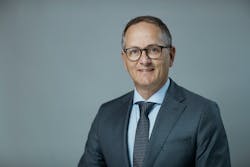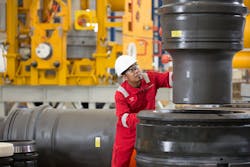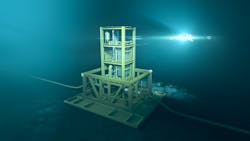Aker Solutions adopts ‘intelligent’ approach to subsea field optimization
Aker Solutions claims its new ‘Intelligent Subsea’ approach can halve the cost of subsea field developments and reduce the time needed to generate optimized subsea field layouts by 75%. Offshore spoke to Knut Nyborg, the company’s Executive Vice-President, about the background to the development and how the company plans to persuade the industry of the benefits of this new approach.
Offshore: What is Intelligent Subsea all about?
Nyborg: Intelligent Subsea enables us to define, execute, and operate tailored and optimized subsea solutions based on standardized components, providing real total cost optimization over the life of the field. It brings cost, schedule, and quality improvements from re-using standardized products, and field optimization potential from applying bespoke solutions. The combination of automated engineering software, configurable product platforms and standardized hardware components mean we can automate more of our execution and thus reduce project engineering lead times. The effects of standardization has reduced engineering hours by 60-70% in some areas, cut assembly hours 25% and reduced procurement cost and lead time. These kinds of efficiencies are only possible through standard, configurable products. Our latest generation of subsea equipment is standardized, smaller, lower cost and simpler - ensuring predictable quality, repeatable volumes, and accelerated delivery.
Standard, configurable product platforms based on standardized hardware components (Product Catalogue) is a key enabler in Intelligent Subsea. Combined with our automated engineering and configuration software (Insight) we can automate more of our execution and reduce project engineering lead times.
Offshore: Can this approach be adapted to changes in the subsea system, which can be frequent as the design evolves?
Nyborg: Digitally-enabled design helps us drive efficiency and standardization in our design processes to rapidly create, test, and adjust design concepts based on standardized products and components, with each field development proposal costed. Changes to the subsea system are seen in the context of corresponding efficiencies in topside facilities and wider infrastructure to ensure the most efficient design possible. Our digital tools can reduce concept selection timelines dramatically. Software applications in ix3’s Concept Insight and Engineering Insight portfolios shorten the time it takes to select the best subsea layout by 75%.
Using our Subsea Configurator, we can rapidly search our product catalogue to find standardized components and products that fulfill a specific field configuration and related design parameters such as pressure, temperature, water depth, fluid composition and so on. This significantly improves speed, consistency, and accuracy.
During execution, our configuration and design automation tool can cut engineering hours by up to 90%. In the case of wellhead systems, we have developed a configuration and design automation tool which can cut engineering hours by up to 90% and lead time by half. The end result is a cost-effective product that reduces time to first oil. During the operations phase, our digital insight, predictive maintenance, standardized equipment and enhanced oil recovery techniques, can drive lower operating costs, increased uptime and extended field life.
Offshore: Is the concept being pitched mainly at the company’s established clients in the North Sea area?
Nyborg: Intelligent Subsea is relevant worldwide. The core value of this approach is found in the intersection of three themes - integrated system design, which encapsulates the complete system not just subsea; accelerated field development, through standardized design and manufacturing; and maximized performance, through life of field via advanced condition monitoring and predictive maintenance, enhanced recovery solutions, and simplified system extensions. The company does have a strong track record on the Norwegian continental shelf as well as West Africa and Brazil. We are applying this integrated system thinking with customers in many regions, and we believe it is the right approach for deepwater developments. It directly solves performance issues with fit-for-purpose products designed for installability and flow assurance, both essential in deepwater.
Offshore: Does the concept work best with new or bolt-on offshore developments?
Nyborg: It works equally well for greenfield projects and for brownfield projects. The core of Intelligent Subsea is still the automated design using standard configurable product platforms. This is valid for any type of field. For example, our Subsea Alliance with Aker BP and Subsea 7 supported the brownfield development of the Alvheim area in the Norwegian North Sea. This involved the development and tieback of mature fields to an existing FPSO to ensure high capacity utilization. With our digitally-enabled approach, and cooperation with our alliance partners, we were able to shorten the schedule from 22 to 13 months and deliver a 30% cost reduction.
Look at marginal tiebacks in general. One of the key drivers is maximizing capacity utilization on an existing topside facility. By applying our system thinking approach we can optimize the field design, taking into account all client priorities, both topside and subsea. Capex and schedule often have a huge impact on the subsea production system (SPS) development case; while both are important drivers for the topside facility, it is also critical to design potentially new topside equipment according to size and weight requirements for the dedicated topside in addition to existing capacities for power and utilities. And to ensure that execution of the work can be performed in planned revision stops or with a minimum of ‘hot work’, which requires shutdowns of ongoing production.
Offshore: Is the concept applicable solely to Aker Solutions subsea products?
Nyborg: Our digital technologies are applicable to multiple vendor products. For example, ix3’s Subsense field condition and performance monitoring tool is monitoring a UK subsea field where we have delivered the controls, but the trees were delivered by a different vendor. Through our own alliances, we are used to dealing with products from a mix of vendors. By applying our digital tools in the front-end phase, we can define optimized field design solutions and accommodate aspects such as installed infrastructure and use of existing spare parts and tool sets.
Offshore: Is full alignment needed among all major parties in a project, from start to finish, for the concept to work?
Nyborg: No, major parties do not have to be fully aligned from the outset – but what makes a difference is early engagement in the front-end phase. Understanding the interfaces between the parties in the front-end phase and ensuring that inter-dependencies are taken into consideration when establishing different field solutions are both critical.
Offshore: Can you outline some of the benefits of standardization that this new approach provides?
Nyborg: We have standardized many deliverables that would have been variable between projects a few years ago. For example, our vertical trees are absolutely standard but at the key function or component level. A client may, for example, select a 5-in. outlet for an oilfield and a 7-in. outlet for a gas field. Both outlets are standardized, and both have the same interfaces. This means they can be configured to different field conditions and functional requirements by simply selecting the best suited standard components for each function.
The Vectus control system is also standard on every project with field variability done only at a software level. Using the SCM configurator software tool has been proven to cut engineering hours by 90%. The engineer is guided through a set of configurations based on the product structure, generating hydraulic and electrical schematics as examples. Years ago building a project could take many hundreds of hours but this can now be done in minutes, with the added benefit of predictable and repeatable quality and delivery.
The standardized approach means that subsea fields can be easily extended and upgraded as the field matures. In the case of the Troll field in the North Sea which has been in production since 1995, Aker Solutions more recently applied its subsea configurator tool to prove examples of reduced well-set installation costs by up to 70% through rigless operations. We introduced Vectus controls, enabling seamless phasing in of future expansion tiebacks and data-driven insight with Subsense condition performance monitoring software.
Offshore: For marginal tiebacks, Aker Solutions claims to be able to achieve a 50% capex reduction with a new subsea pumping solution. How is this achieved?
Nyborg: When the FASTsubsea X multiphase pump module is qualified and deployed, FASTsubsea estimates that capex for a pumping system can be reduced by 30-50% compared to conventional subsea pumping system costs. The rapidly deployable FASTsubsea multiphase pump solution has no need for topside infrastructure, therefore offering significantly reduced capex. The project was established in April 2019, and we are currently approaching potential JIP partners for funding.
Offshore: Can you explain some of the benefits provided by the company’s digital tools and ix3’s ‘Insight’ modules, as applied to Intelligent Subsea?
Nyborg: We have a range of advanced recovery enhancement technologies that boost recovery and extend the life of the field as reservoir pressure drops and recoverable reserves become harder to reach. Re-applying the configurator apps in ix3’s Concept Insight portfolio, working with our front-end teams, and using the latest innovation of intelligent products, we can re-invent the field both subsea and topside and extend production.
Aker Solutions has a long history and extensive experience with field designs across all regions. Prioritization of different client drivers enables different field designs and with these digital tools we can now us this experience to create a set of different field solutions. And when we put in the field-specific design parameter, for example, pressure, temperature, water depth, our digital tools will populate the field solutions with feasible technology within our database.
In other words, our front-end field modeler and subsea configurator apps, part of the Concept and Engineering Insight portfolios, work together with our other automation tools to help engineers’ decision making. Multiple fully-costed scenarios can be trailed in a short space of time.
Offshore: Aker Solutions is working on a project in the Barents Sea involving a 190-km (118-mi) subsea tieback of a gas system. Is Intelligent Subsea assisting this development?
Nyborg: Intelligent Subsea can be used for any field. The Concept Insight tool is used to develop, test, and cost alternative field configurations. For long tiebacks it is important to consider two main aspects - one, the flow assurance aspect of transporting hydrocarbons across long distances and two, ensuring capacity for power (hydraulic and electric), utilities and communication. Intelligent Subsea interfaces both multiphase flow simulators, integrated production modeling tools as well as normal steady state process simulation tools. These are used to define the overall field configuration as well as defining the relevant field design conditions. This provides input to the Subsea Configurator when searching for standardized and proved products and components.
This particular project is an example of the company’s integrated system thinking approach, meaning we challenged assumptions, rapidly trialed multiple scenarios of a full field system, applied innovative technology, and adapted our solution to use the existing infrastructure. This allowed the reduction of the capex and opex costs, mainly by avoiding the need for a topside production platform.
Offshore: Can you comment on some of the other product innovations relevant to Intelligent Subsea?
Nyborg: The company has developed a configuration and design automation tool that cuts engineering hours by up to 90% and lead times by half. Standardizing on component level and enabling configuration of the wellhead system to meet the field requirements are key to achieving these efficiencies. Standardization enables us to use the design automation tool to generate the drawings required. This results in repeatability and volumes for our engineers, manufacturing and suppliers, as well as predictability when it comes to quality and delivery.
The sixth generation of the Vectus controls system is being deployed for the first time this year. It is central to Aker Solutions’ condition monitoring and predictive maintenance offering. •
About the Author
Jeremy Beckman
Editor, Europe
Jeremy Beckman has been Editor Europe, Offshore since 1992. Prior to joining Offshore he was a freelance journalist for eight years, working for a variety of electronics, computing and scientific journals in the UK. He regularly writes news columns on trends and events both in the NW Europe offshore region and globally. He also writes features on developments and technology in exploration and production.




